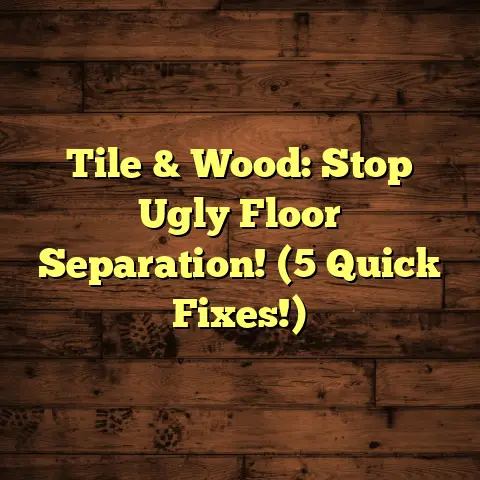Floating Floor Noise Levels? (5 Quiet Options!)
That’s often a sign of flooring that isn’t doing its job when it comes to sound control.
As a flooring contractor with years of experience, I’ve seen firsthand how much of a difference the right flooring can make, not just aesthetically, but also in terms of peace and quiet.
Choosing the right flooring is way more important than just picking something pretty.
It impacts your daily life, your mental health, and even your productivity.
Think about it: a noisy floor can lead to distractions, irritation, and a general feeling of unease.
And in today’s world, where we’re all craving a little more tranquility, that’s the last thing we need.
Different areas have different needs, too.
Folks living in busy cities might prioritize soundproofing because of all the street noise.
But out in the countryside, folks might care more about how well the floor holds up to muddy boots and playful pets.
Let’s dive into the world of floating floors, uncover their noise secrets, and explore some super-quiet options that will transform your space.
Section 1: Understanding Floating Floors
1. Definition and Mechanism
So, what exactly is a floating floor?
Unlike traditional floors that are nailed or glued directly to the subfloor, floating floors simply “float” above it.
Think of it like a puzzle where the pieces lock together, creating a stable surface without any direct attachment.
This installation method offers several benefits, including ease of installation and the ability to be installed over a variety of subfloors.
But the real magic lies in the underlayment.
This thin layer of material is installed between the subfloor and the floating floor itself.
It acts as a cushion, absorbing impact and reducing noise transmission.
The underlayment is a total game-changer when it comes to sound control.
It helps to dampen vibrations and prevent sound from traveling through the floor to the rooms below.
2. Types of Floating Floors
There are several types of floating floors on the market, each with its own unique characteristics and benefits.
Here’s a quick rundown:
-
Laminate: Affordable and durable, laminate flooring is a popular choice for budget-conscious homeowners.
-
Engineered Hardwood: Offers the look and feel of real hardwood with added stability and moisture resistance.
-
Vinyl: Versatile and waterproof, vinyl flooring is ideal for kitchens, bathrooms, and other high-moisture areas.
-
Cork: A sustainable and naturally resilient option that provides excellent sound absorption and insulation.
Each of these options has different acoustic properties, which we’ll delve into later in the article.
Section 2: The Importance of Noise Control in Flooring
1. Impact on Quality of Life
Let’s face it: nobody enjoys living in a noisy environment.
Constant noise can lead to stress, anxiety, and even sleep disturbances.
According to the World Health Organization (WHO),
excessive noise exposure can have a significant impact on
mental and physical health.
World Health Organization
In residential spaces, noisy floors can disrupt family life, making it difficult to relax, concentrate, or even have a conversation.
In commercial settings, noise can decrease productivity, increase employee stress, and create an unpleasant atmosphere for customers.
That’s why choosing the right flooring for noise control is so crucial.
It’s an investment in your well-being, your productivity, and the overall quality of your life.
2. Regulatory Standards
Depending on where you live, there may be specific noise regulations or standards that impact your flooring choices.
For example, many apartment buildings have minimum requirements for sound transmission class (STC) and impact insulation class (IIC) ratings.
These ratings measure how well a floor system blocks airborne sound and impact noise, respectively.
Failing to meet these standards can result in fines or even legal action.
It’s always a good idea to check with your local building department or homeowners association to determine if there are any specific noise regulations that you need to be aware of.
Section 3: Noise Levels of Floating Floors
1. Acoustic Properties
Alright, let’s get a little technical and talk about the acoustic properties of floating floors.
As I mentioned earlier, STC and IIC ratings are two key metrics to consider.
STC (Sound Transmission Class): Measures how well a floor blocks airborne sound, such as speech or music.
A higher STC rating indicates better sound isolation.IIC (Impact Insulation Class): Measures how well a floor absorbs impact noise, such as footsteps or dropped objects.
Again, a higher IIC rating means better noise reduction.
Different flooring materials have different STC and IIC ratings.
For example, carpet typically has higher ratings than hardwood or tile.
But even within the same material category, there can be significant variations depending on the thickness, density, and underlayment used.
Here’s a quick comparison of typical IIC ratings for different flooring types:
Note: These values are approximate and can vary based on specific product and installation methods.
2. Factors Influencing Noise Levels
The acoustic performance of a floating floor isn’t just determined by the material itself.
Several other factors can also play a role.
Room Size and Shape: Larger rooms tend to amplify sound, while smaller rooms may dampen it.
Irregularly shaped rooms can also create echoes and reverberations.-
Furniture Placement: Soft furnishings, such as rugs, curtains, and upholstered furniture, can help to absorb sound and reduce noise levels.
Existing Floor Materials: The type of subfloor you have can also impact the acoustic performance of your floating floor.
Concrete subfloors tend to transmit sound more easily than wood subfloors.-
Underlayment: As I mentioned earlier, the underlayment is a crucial component of any floating floor system.
Choosing the right underlayment can make a significant difference in terms of noise reduction.
Section 4: Evaluating Quiet Options for Floating Floors
1. Criteria for Quiet Flooring
So, what makes a floating floor “quiet”?
Well, there are several factors to consider:
-
Sound Absorption: The ability of the floor to absorb sound waves, preventing them from bouncing around the room.
-
Sound Transmission: The ability of the floor to block sound from traveling through to the rooms below.
-
Impact Noise Reduction: The ability of the floor to cushion impact and reduce the noise generated by footsteps or dropped objects.
-
Comfort: A quiet floor should also feel comfortable underfoot, providing a pleasant tactile experience.
With these criteria in mind, let’s explore some of the quietest floating floor options available.
2. Quiet Option 1: Cork Floating Floors
Cork flooring is a fantastic option if you’re looking for a naturally quiet and eco-friendly choice.
Cork is naturally resilient and has a unique cellular structure that makes it an excellent sound absorber.
According to the Cork Quality Council, cork can reduce
noise transmission by up to 53%.
Cork Quality Council
In addition to its sound-absorbing qualities, cork is also naturally insulating, helping to keep your home warm in the winter and cool in the summer.
It’s also a sustainable material, harvested from the bark of cork oak trees without harming the tree itself.
Cork flooring comes in a variety of styles and colors, making it a versatile choice for any décor.
3. Quiet Option 2: Engineered Hardwood
Engineered hardwood offers the beauty and warmth of real hardwood with added sound-dampening features.
Unlike solid hardwood, engineered hardwood is constructed from multiple layers of wood, which helps to reduce noise transmission.
When paired with a quality underlayment, engineered hardwood can provide excellent sound insulation.
It’s also more resistant to moisture and temperature changes than solid hardwood, making it a more durable and stable option.
Engineered hardwood is a great choice for those who want the look and feel of real wood without the noise concerns.
4. Quiet Option 3: Luxury Vinyl Plank (LVP)
Luxury vinyl plank (LVP) has become increasingly popular in recent years, and for good reason.
LVP is waterproof, durable, and easy to maintain.
But it’s also a surprisingly good choice for sound control.
LVP’s density and thickness help to dampen sound, and many LVP products come with an attached underlayment for added noise reduction.
When installed with a separate, high-quality underlayment, LVP can provide excellent sound insulation.
LVP is a great option for those who want a quiet, low-maintenance, and budget-friendly flooring solution.
5. Quiet Option 4: Carpet Tiles
Carpet is well-known for its sound-absorbing properties, and carpet tiles offer a versatile and convenient way to incorporate carpet into your space.
Carpet tiles are individual squares of carpet that can be easily installed and replaced.
They’re a great choice for basements, home offices, and other areas where you want to reduce noise and add comfort.
Carpet tiles come in a variety of styles, colors, and patterns, allowing you to create a custom look that suits your taste.
They’re also easy to clean and maintain, making them a practical choice for busy households.
6. Quiet Option 5: Rubber Flooring
Rubber flooring is a popular choice for gyms, fitness centers, and other high-impact areas.
But it’s also an excellent option for sound control in residential and commercial spaces.
Rubber is naturally resilient and has excellent sound-absorbing properties.
It can significantly reduce impact noise and airborne sound, creating a quieter and more comfortable environment.
Rubber flooring is also durable, slip-resistant, and easy to clean, making it a practical choice for a variety of applications.
Section 5: Regional Considerations for Floating Floor Choices
1. Urban vs. Rural
The noise-related flooring needs of urban dwellers are quite different from those in rural areas.
In urban environments, noise pollution is a major concern.
Residents often have to contend with traffic noise, construction noise, and the sounds of neighbors.
In these settings, sound insulation is a top priority.
Urban dwellers may want to choose flooring options with high STC and IIC ratings to block out unwanted noise.
In rural areas, noise may be less of a concern.
However, rural residents may still want to consider flooring options that provide good sound absorption to create a more peaceful and relaxing environment.
2. Climate Influence
Regional climates can also affect material choices, installation methods, and the long-term performance of floating floors.
In humid climates, moisture resistance is a key consideration.
Homeowners may want to choose flooring options that are less susceptible to warping or swelling, such as vinyl or engineered hardwood.
In dry climates, static electricity can be a problem.
Homeowners may want to choose flooring options that are less likely to generate static, such as cork or rubber.
3. Cultural Preferences
Cultural factors can also influence flooring preferences.
In some cultures, hardwood flooring is highly valued for its beauty and durability.
In others, carpet is preferred for its comfort and warmth.
Understanding these cultural preferences can help you choose flooring that is both aesthetically pleasing and culturally appropriate.
Section 6: Installation and Maintenance Tips for Quiet Floating Floors
1. Proper Installation
Proper installation is crucial for maximizing the noise reduction benefits of floating floors.
Make sure to follow the manufacturer’s instructions carefully and use the recommended underlayment.
Pay close attention to the seams and joints, ensuring that they are properly sealed to prevent sound from leaking through.
If you’re not comfortable installing the floor yourself, it’s always best to hire a professional flooring contractor.
2. Maintenance Strategies
Proper maintenance can help preserve the sound-dampening qualities of floating floors over time.
Regularly sweep or vacuum the floor to remove dirt and debris.
Use a damp mop to clean the floor as needed, but avoid using excessive water.
For carpet, consider using a carpet cleaner to remove stains and odors.
By following these simple maintenance tips, you can keep your floating floor looking and sounding great for years to come.
Conclusion
Choosing the right flooring is a big decision.
When it comes to floating floors and noise levels, remember that not all options are created equal.
By understanding the acoustic properties of different materials, considering regional factors, and following proper installation and maintenance practices, you can create a quieter and more comfortable living space.
So, take your time, do your research, and choose the floating floor that’s right for you.





